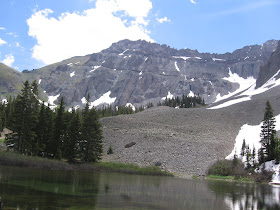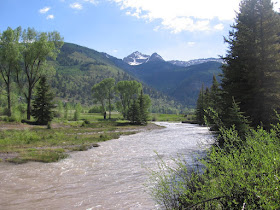I started at the south trail head along Forest Road 535. Traveling from the south this is about 25 miles north of the town of Dolores along paved roads. From Telluride, Road 535 intersects with Highway 145 a few miles south of Lizard Head Pass and is marked as the Dunton Road.
 The trail is a 4WD drive road that climbs steadily with switchbacks. The lower part of the route has good views to the south down the West Fork valley and across the valley to Stoner Mesa. There are other trail heads nearby, the Goble Trail and Fish Creek Trails are just to the south and the north end of the Stoner Mesa Trail is across the valley on top of the mesa.
The trail is a 4WD drive road that climbs steadily with switchbacks. The lower part of the route has good views to the south down the West Fork valley and across the valley to Stoner Mesa. There are other trail heads nearby, the Goble Trail and Fish Creek Trails are just to the south and the north end of the Stoner Mesa Trail is across the valley on top of the mesa.  Further up the views open up to the north toward the Rico Mountains. I was hoping to see the high peaks of the Lizard Head area but no luck. The lower trail forest has Ponderosa Pines and Aspens and Gambel Oak and a few Narrow Leaf Cottonwoods.
Further up the views open up to the north toward the Rico Mountains. I was hoping to see the high peaks of the Lizard Head area but no luck. The lower trail forest has Ponderosa Pines and Aspens and Gambel Oak and a few Narrow Leaf Cottonwoods. After 2:00 hours and about five miles I arrived at what I took to be the loop junction. I stayed to the right, still on Road 727, which seemed to continue to climb slightly.
The route to the left is narrower and seems to stay along a level contour. The forest here is dominated more by Engelmann Spruce and there are views to the west over Fish Creek to Black Mesa.
 I continued on for another 40 minutes and there were a few glimpses of Dolores Peak and a distant glimpse of El Diente but the views were mostly obscured by the thick forest.
I continued on for another 40 minutes and there were a few glimpses of Dolores Peak and a distant glimpse of El Diente but the views were mostly obscured by the thick forest. I think that the north end of this route has the second hut on the Durango to Moab hut to hut mountain bike route but I didn't go that far. The first hut is near Bolam Pass at the east end of the East Fork Trail. I turned around after 2:40 hours and returned for a total hike of 5:00 hours.
I think that the north end of this route has the second hut on the Durango to Moab hut to hut mountain bike route but I didn't go that far. The first hut is near Bolam Pass at the east end of the East Fork Trail. I turned around after 2:40 hours and returned for a total hike of 5:00 hours.
 After about ten minutes on the Cross Mountain Trail, the Groundhog Stock Trail branches off to the left and travels to the southwest along the edge of the Lizard Head Wilderness Area. This area has three of the Colorado 14ers, plus the unique Lizard Head formation.
After about ten minutes on the Cross Mountain Trail, the Groundhog Stock Trail branches off to the left and travels to the southwest along the edge of the Lizard Head Wilderness Area. This area has three of the Colorado 14ers, plus the unique Lizard Head formation.










 The Navajo Lake Trail head is about 1.2 miles to the west. The two trails run parallel to the north for about three miles. The Kilpacker Trail provides access to the Kilpacker Creek Basin for those attempting to climb El Diente, at 14,159 feet, one of the Colorado 14ers. El Diente is a tooth shaped peak just to the north of Mt. Wilson, also a 14er.
The Navajo Lake Trail head is about 1.2 miles to the west. The two trails run parallel to the north for about three miles. The Kilpacker Trail provides access to the Kilpacker Creek Basin for those attempting to climb El Diente, at 14,159 feet, one of the Colorado 14ers. El Diente is a tooth shaped peak just to the north of Mt. Wilson, also a 14er.




















 Normally, a paved trail next to a highway wouldn't be a hikers choice, but the views in the Telluride Valley Floor are worth it and the Bike Trail completes a six mile loop with the River Trail on the south side of the canyon. The Bike Trail includes a tunnel under the spur route into Telluride town. Towards the west end of the trail the San Miguel River starts to come more into view.
Normally, a paved trail next to a highway wouldn't be a hikers choice, but the views in the Telluride Valley Floor are worth it and the Bike Trail completes a six mile loop with the River Trail on the south side of the canyon. The Bike Trail includes a tunnel under the spur route into Telluride town. Towards the west end of the trail the San Miguel River starts to come more into view. 











